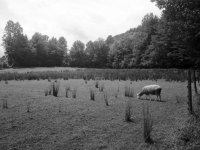Live in the Desert; Live Longer

Today I spent some time in a secret archive in the Public Library here in Joshua Tree. Penny who works there is the most helpful, and she showed me lots of old files about the history of Joshua Tree. I am really intrigued by the homesteading that took place out here from the 1930s until the 1970s. The Small Tract Act was passed in 1938, homesteaders could build small structures on 5 acres, and be deeded the land by the Bureau of Land Management. Penny was telling me about a certain Colonel E B Moore who heavily promoted the Desert Lifestyle, specifically the “little piece of heaven” that was the 5-acre tract of land. He set up an office in downtown JT, where the Mojave Land Trust is now located (also an entity interested in the definition and functioning of the land in the desert). By 1955, 43,000 5-acre tracts had been filed, it was desert fever! Joshua Tree was known at the 5 Acre Capital of the World! Thousands of small cabins (only had to be 12 x 6 ft !) still dot this landscape. This myth and magic of desert living for some was just that; they could not handle the harshness of this land, now many lay abandoned with the tell-tale overhanging roofs angeled upward towards the sky. Stay tuned for more thoughts related to homesteading. I am planning an event celebrating the 150th anniversary of the Homesteading Act.

Katie Bachler was our first HDTS Scout, and was in residence from 2012-2013.
The HDTS Scout Residency is dedicated to learning more about the people and places that make up our diverse and ever evolving community.
During Katie’s residency, visitors were invited to drop into the HDTS HQ, the Scout’s home base, to meet Katie, who could be found making maps, hosting conversations, and baking bread – in between her off-site adventures around town and out in the field.
Katie had a lot in store during her time here, including:
- a series of talks featuring local experts
- joining together to create a web of knowledge
- a research library and archive documenting the many spaces, places, plants, and people that make up this special region
- casual conversations with drop in visitors over tea
- site visits and field trips around town
Katie engaged the community by instigating map-making and rag-rug braiding workshops, the Scout’s Book Club, Art in the Environment classes for desert kids, casual conversations, site visits and field trips—all shared in her Scout’s blog, which serves as the foundation for her book.







































